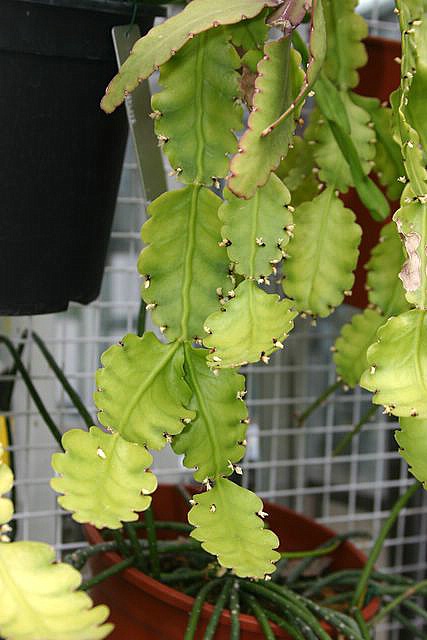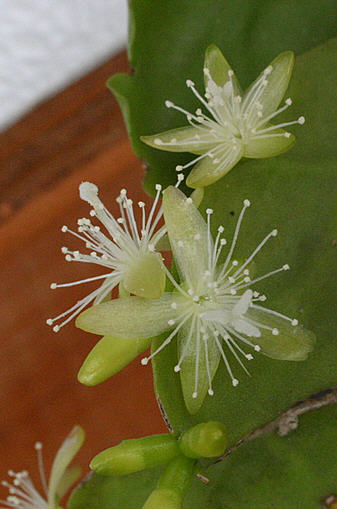|

R. crispata (copyright KAF, Kew 2006)

R. crispata flower (copyright Ken Friedman)
From Calvente
Thesis 2010
2. RHIPSALIS CRISPATA (Haw.) Pfeiff., Enum. Diagn. Cact.: 130.
1837.
Epiphyllum crispatum Haw., Philos. Mag. J. 7: 111. 1830.
Cereus crispatus Pfeiff., Enum. Diagn. Cact.: 130. 1837, pro
syn.
Rhipsalis crispa F. Forst., Handb. Cacteenk.: 450. 1846, pro
syn.
Rhipsalis rhombea var. crispata K.Schum., Gesamtbeschr.
Kakt.: 638. 1898.-TYPE: BRAZIL. Sao Paulo: Rio Claro, Fazenda Sao Jose,
"a beira da Lagoa", A. Cardoso in Zappi 249 (neotype,
here designated: HRCB!).
? Rhipsalis ß latior Salm-Dyck ex Pfeiff., Enum. Diagn.
Cact.: 130. 1837
- Epiphyte in shaded or open habitat or lithophyte in shaded habitat
, 1-2 m long, branching apical or sub-apical, rare lateral.
- Stem segments flattened in longitudinal section, 0.8-2 mm diam,
olive green sometimes with pinkish margin, slightly succulent but
midrib stiff, dimorphic or monomorphic, midrib 2.5-5 mm diam, cylindric;
primary stem segments up to 50 cm long, 2-winged, cylindric at base,
wings 1.5 cm wide; secondary stem segments (10-)11.5-20(-30) cm long,
base acute, atenuate or wide atenuate, apex truncate; wings 2, (1.5-)2-5.5
cm wide, margin strong crenate to lobed, undulate or strong undulate,
with 4-10(-17) mm projections.
- Areoles between margin projections, 1.3-5 cm apart, first of segment
0.5-4.5 cm distant from segment base; when sterile 1.3-2.5 mm diam,
glabrous or with 1-4 acicular scales; when fertile 2-5 mm diam, with
3 pink acicular scales or scarce hairs at margin, 1-7 flowers/fruits.
- Flowers 15-17.5 mm diam; pericarpel 3.2-3.5 X 3-4 mm, cylindric
to obovoid, yellowish green with dark reddish apex, glabrous; with
2-4 sepaloid tepals, 0.5-2 mm long and 6-7 petaloid tepals, 3-9 X
3-5 mm, wide elliptic or elliptic, sub-erect to reflexed, yellowish
with dark reddish apex, apex rounded, curved inwards to cucullate,
margin straight or curved inwards.
- Style 4-5 mm long; stigma with 3-7 lobes, 2.2-2.3 mm long, ligulate,
spreading.
- Ovules in 4 incomplete septa, funicle short
(< 0.5 mm long).
- Stamens 70-80, 4-7 mm long, internal shorter, internal erect and
external facing inwards, white.
- Nectary ca. 0.8 mm long. Fruit 5-7 X 3.5-5.5 mm, elongate globoid
to sub-cylindric, whitish green, sometimes with pinkish apex, glabrous.
Figure 4: A, G.
Notes; This species was originally described from cultivated material
of unknown provenance. Barthlott and Taylor (1995) selected the material
that was cultivated in Europe and kept under this name at the time of
the publication of the neotype for this species. However, the specimen
selected by Barthlott and Taylor (1995) was not found (A. Cardoso in
Zappi 249, Kew spirit collection), and extant material of the collection
A. Cardoso in Zappi 249 (HRCB) was here selected as a new neotype of
R. crispata. An ex-neotype is also preserved at Kew's living collection.
Because Rhipsalis crispata remained without a clear type between
1830 (original description of the species) and 1995 (neotypification
by Barthlott and Taylor), the circumscription of this species remained
problematic for over 150 years. More specifically, several authors misidentified
specimens of R. pachyptera, R. elliptica, R. oblonga, R russellii
and R. olivifera as R. crispata. This confusion is
well justified given the morphological similarity between Rhipsalis
crispata and those species, particularly in terms of the white fruits
and stem segments with crenate to lobed margins, sometimes undulate.
Nevertheless, R. crispata can be distinguished from these taxa by its
deeply pronounced stem margin projections, large areoles, conspicuously
apparent midrib and stem venation.
Habitat and distribution: Occurs mainly in Rio de Janeiro and Sao Paulo
in the Atlantic Forest sensu lato, also occurring in gallery forests
and semideciduous Forests towards the interior of the state of Sao Paulo.
It also occurs further North in Bahia (Brazil). Figure 5.
Rhipsalis crispata (Haworth) Pfeiffer Enum.cact.:130 (1837)
Desc from Hunt 2006
Branch segments flat or sometimes 3 winged, oblanceolate, elliptic or
obovate, 6-10 x 2-4cm, relatively thin, green, margins crenate or repand;
areoles without bristle hairs; flowers (in winter) 1-4 per areole, rotate,
10-12mm diam, creamy white; fruit more or less globose, 6 x 5mm diam.,
white
Desc from B&R 1923
54. Rhipsalis crispata (Haworth) Pfeiffer, Enum. Cact. 130.
1937.
Epiphyllum crispatum Haworth, Phil. Mag. 7: 111. 1830.
Rhipsalis crispata latior Salm-Dyck in Pfeiffer, Enum. Cact.
130. 1837.
Hariota crispata Lemaire, Cact. Gen. Nov. Sp.75. 1839.
Rhipsalis rhombea crispata Schumann, Gesamtb. Kakteen 638.
1898.
Branches divided into short flat joints 6 to L0 cm. long, broad both
at base and apex, green, more or less crenate; flowers solitary or sometimes
2 to 4 at an areole, 10 to 12 mm. broad, cream-colored to light yellow;
filaments numerous; fruit white, 7 mm. in diameter.
Type locality: BraziI.
Distribution: Brazil, but range unknown.
The synonyms R. crispa and its var. major (Forster, Handb.
Cact. 450. 1846) and R. crispa latior Salm-Dyck (Walpers, Repert.
Bot. 2: 279. 1843); Hariota crispata latior Lemaire (Cact.
Gen. Nov. Sp. 71. 1839) doubtless belong here. Schumann, in Nichtrag,,
page 144, refers here Rhipsalis swartziana Pfeiffer.
Pfeiffer publishes as a synonym of the above Cereus crispatus
(Enum. Cact. 130. 1837),
as does also Forster. Schumann (Gesamtb. Kakteen 638. 1898) makes this
species a variety of Rhipsalis rhombea, but later (Gesamtb.
Kakteen Nachtr. 145. 1903) recognizes two species.
Cactus torquatus (Walpers, Repert. Bot. 2:342. 1843), referred
to Rhipsalis rhombea by Walpers, was only a garden name.
Illustrations: Arch. Jard. Bot. Rio de Janeiro 1: pl. 16, as R.
rhombea; Gartenwelt 13: 117; Garten-Zeitung 1: 459. f. 109; Rev.
Hort. 85: f. 152, in part.
Plate XXXV, figure 3, shows a flowering plant received from A. Berger
in 1908. Figure 232 is from a photograph of Miss Eaton's painting of
the plant obtained by Dr. Rose in Brazil in 1915 (No. 20708) which flowered
and fruited in the New York Botanical Garden in 1922.
Notes from Bradleya 13
DISTRIBUTION. Brazil (Pernambuco, Rio de Janeiro, Sao Paulo): terrestrial
and epiphytic, in coastal dunes, brejolagreste forest and subhumid restinga,
Atlantic and Planalto forest, sea level to C. 900 m altitude.
The use of the name R. crispata for this plant is clearly
supported by early herbarium records from the last century in Europe,
where it was being grown under Haworth's epithet, e.g. at Hort. Bot.
Leuven (Louvain), Belgium, 1837, ex Herb. Martens (BR!), and at Munich.
3 Jan. 1850, ex Herb. Kummer (M!). In nature it appears to be a rare
plant, perhaps because much of its former habitat has been destroyed,
and at present its distribution appears to be markedly disjunct, comprising
inner Sao Paulo (Altinopolis & Rio Claro). lowland and coastal Rio
de Janeiro (Silva Jardim, Saquarema & Cabo Frio) and Pernambuco
(Caruaru).
A specimen of undoubted R. crispata, said to emanate from Jujuy,
Argentina (J. West 6220, coIl. 10 Mar. 1935, cult. Bot. Gard. Univ.
California, 1 Feb. 1953 [NY!, US!]), is regarded as having dubious provenance
details.
|

